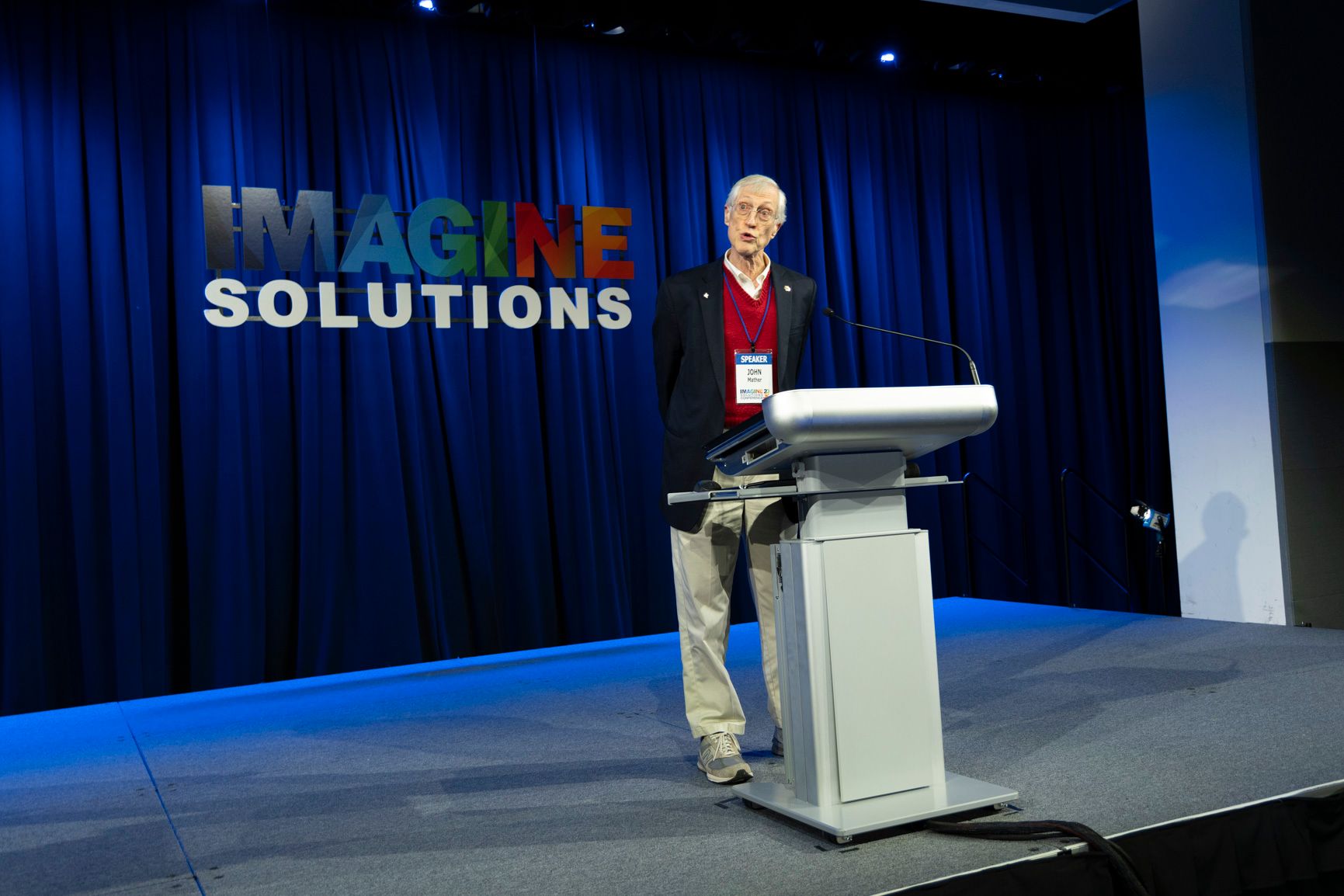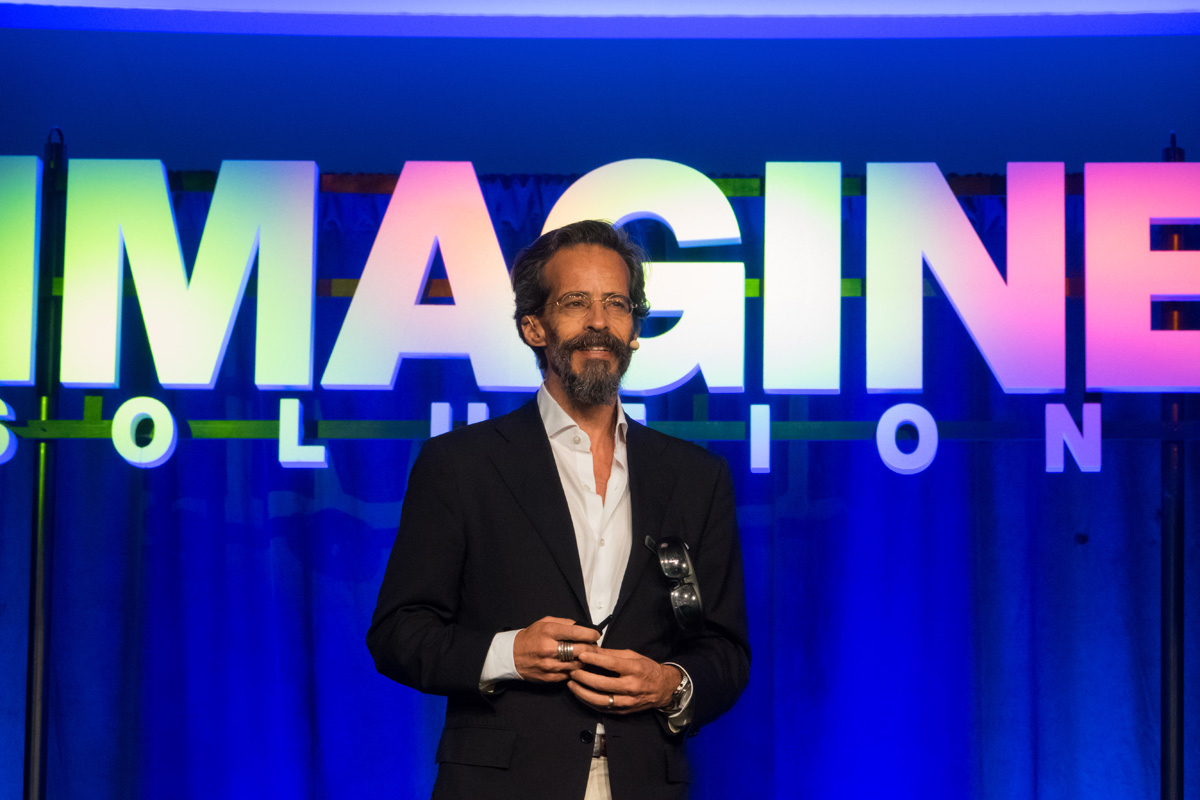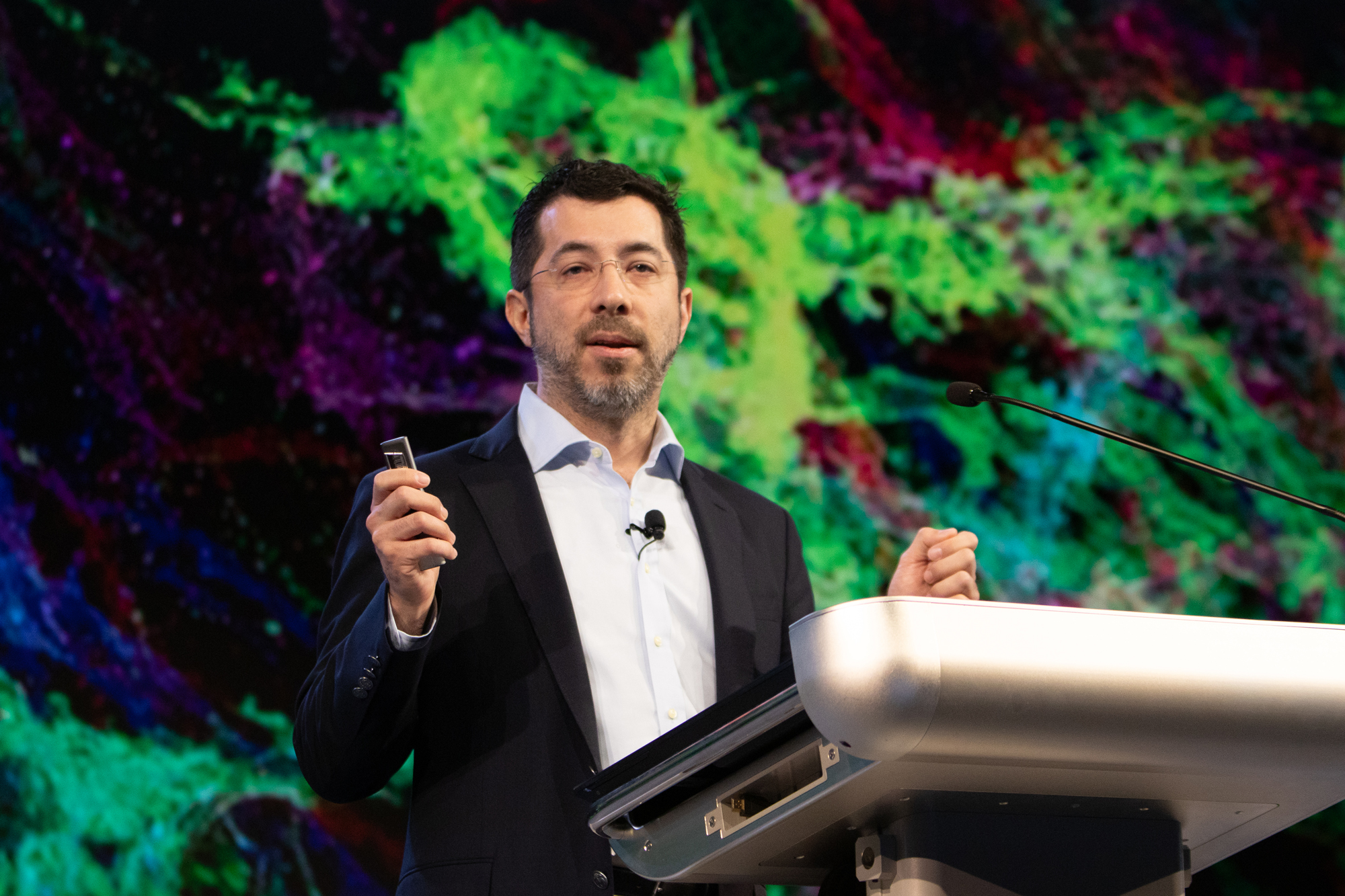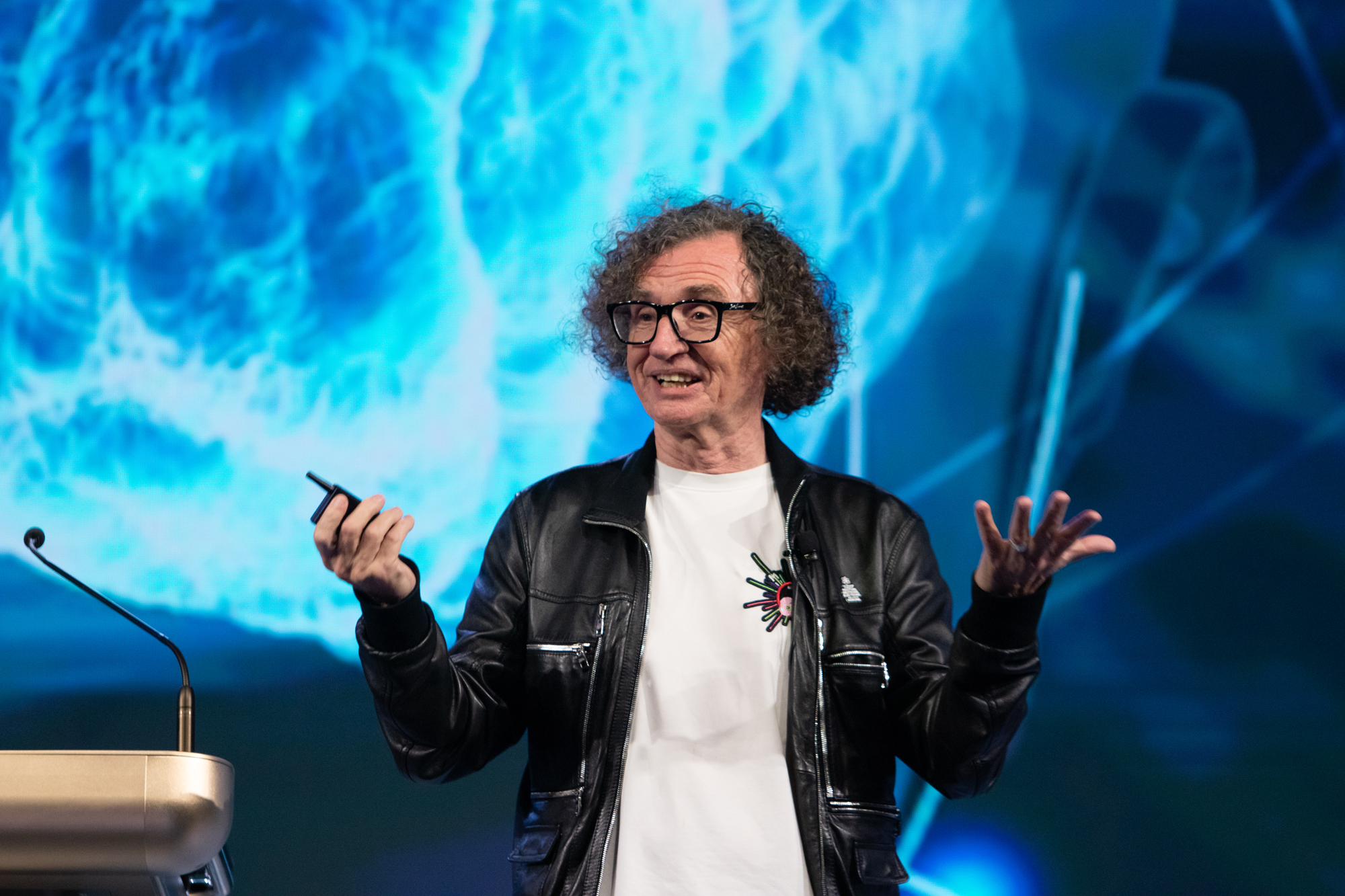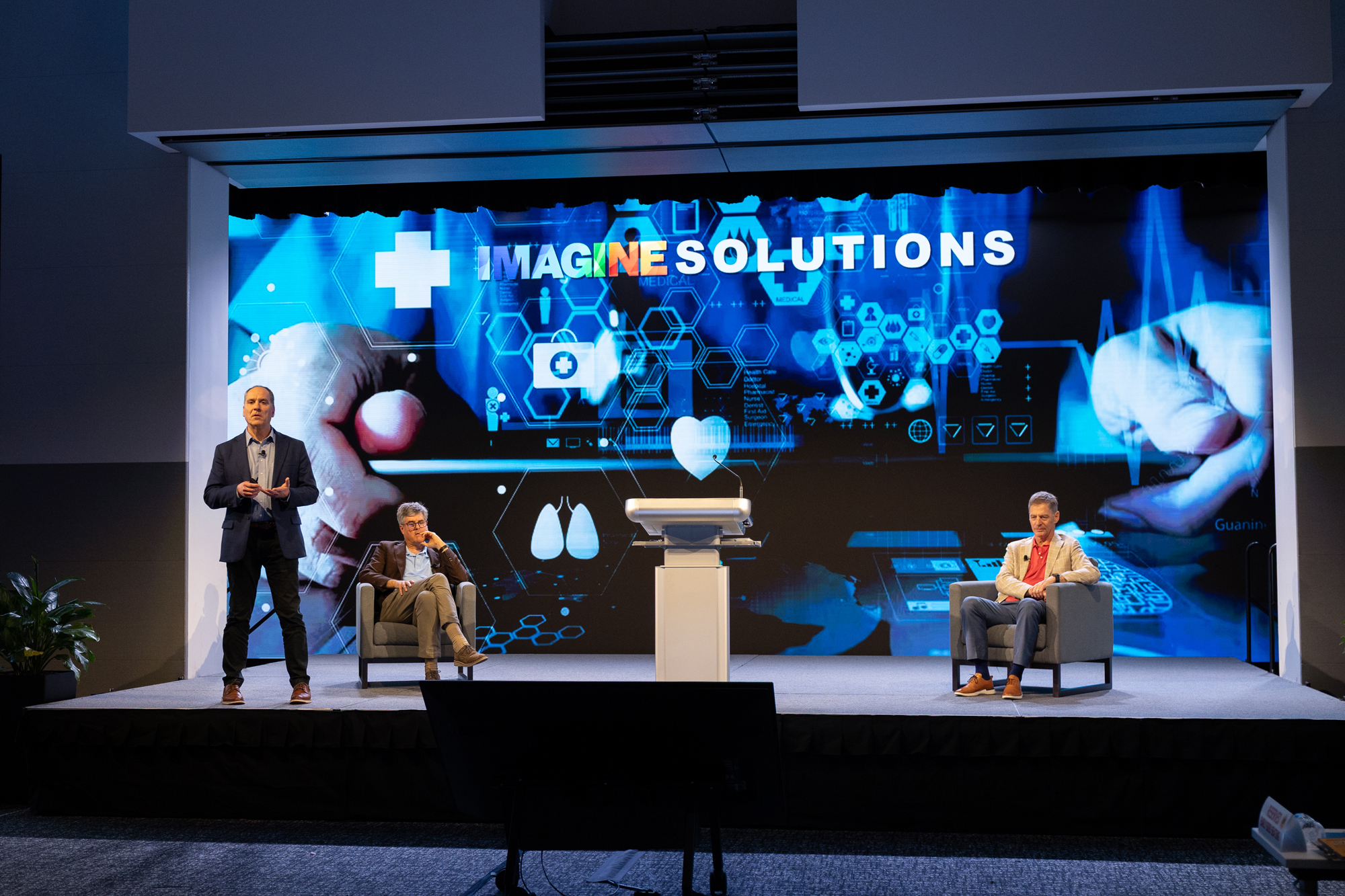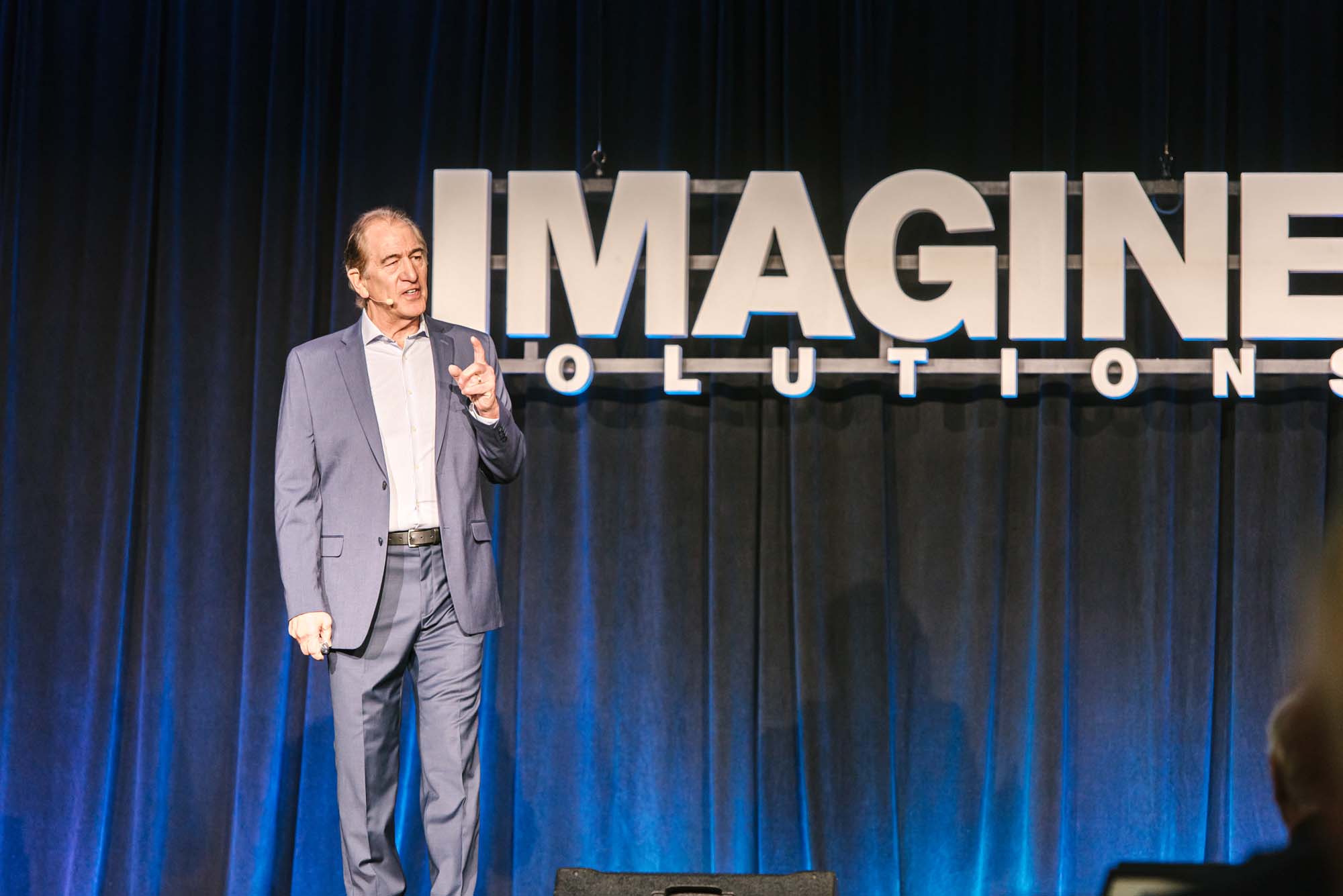Neuroscience Research
MIT neuroscientist Nancy Kanwisher offered a fascinating glimpse into the architecture of the human brain. She shared how specific regions are specialized for recognizing faces, places, and more, advancing our understanding of both typical and atypical brain function. 3D glasses enhanced her engaging talk blended groundbreaking science with real-world relevance, leaving the audience with a deeper appreciation for the complexity of the mind.
00.00
[Music] nancy canwasher is the walder a rosenblith professor of cognitive neuroscience in the department of brain and cognitive sciences at mit she's also the founder of the renowned mcgovern institute of brain research she studies the neural and cognitive mechanisms underlying human visual perception and cognition so when you say something like i never forget a face she knows how and why that is true in fact last year she was awarded the cavi prize in neuroscience for her discovery of a specialized system within the brain specifically to recognize faces i have a friend in fact a very intelligent friend for whom this is an impairment she cannot recognize a face she knows who you are she knows your voice but she
01.02
can't put your name together with your face nancy grew up in woods hole massachusetts part of a science family and she credits her time in and around woods hole and its research culture as a key reason for her career path in science let's learn now from professor canwasher about how the brain processes data especially visual data and how that knowledge may help us better understand autism she's sneaking up on me i see that she's here nancy welcome thank you it's all yours [Music] hi everyone lucky us to hear all these amazing talks today right i want to start with one of the most uh deep questions that human beings have ever asked themselves and that is this
02.00
what is the nature of the human mind this question has been pondered for millennia by philosophers artists and poets but today we can approach it scientifically and very concretely by studying the organ that implements the mind that is to get insights about the nature of the mind we can look at the functional organization of the brain so at the most general level we can ask whether human minds and brains are composed of specialurpose components each specialized to solve a single specific task or whether we have a more general purpose kind of intelligence with minds and brains that are prepared to tackle a wide range of problems without special purpose machinery for any of them in particular and so this question was fiercely debated for almost two centuries but i think we've pretty much answered it in just the last 20 years so i want to tell you today about i'll give you a whirlwind tour of my small part in that grand adventure and
03.02
it starts with the invention not by me of functional magnetic resonance imaging and the basic idea of fmri is that um neural firing is metabolically expensive and that means that if a bunch of neurons right there in your brain start firing you need to send more blood flow to that part of your brain just as if you run around you need to send increased blood flow to your leg muscles so that's the basic idea and so we decided to use this method to ask whether there's specialized regions in the brain for face recognition and so uh in one of our early experiments we simply popped people in the scanner and scanned their brains while they looked at images of faces and images of objects and we asked are there any parts of their brain that produce a higher mri signal or higher neural activity when they were looking at faces than objects and so here's me doing that uh experiment about 25 years ago and what you see in gray is a bunch of
04.00
slices through my brain like this starting from uh the bottom and the and the upper where's my mouse right there uh it's the bottom of my brain and as we go rightwards we're going up in the brain and if you look closely you'll see a tiny little dot right there uh and that's a region where the statistics are telling us that the mri signal was higher when i was looking at faces these are these higher peaks than when i was looking at objects and so we thought that was pretty cool and we scanned me again and saw it again and scanned me again and saw it again and then we scanned a bunch more people and we found a similar little blob that behaved like that in pretty much everyone we scanned and then we tested the response measured the response of that little region in a whole bunch of different conditions and we found that it responds really strongly to all different kinds of face images and it responds much less to a whole bunch of images that weren't faces and so we concluded that that region really responds selectively to faces and that's pretty cool but it doesn't really
05.00
answer the question we really want to know the question we really want to know is um do you need that region for face recognition does it play a causal role in your ability to recognize faces and so to answer that question you can't just measure responses from the brain you have to disrupt the brain and that's why i was really excited when i got a phone call a bunch of years ago from a colleague telling me that this gentleman right here was awaiting neurosurgery in a hospital in japan neurosurgery for intractable pharmacologically resistant epilepsy and so to try to treat his epilepsy the neurosurgeons had placed electrodes all over the bottom of his brain here um and the reason that that was interesting to me uh is by comparison here's the bottom of my brain showing you my face selective regions in red and you can see that the electrodes in this guy's brain go over right over the territory that looks like that might be where his face regions were so we quickly emailed them some images uh and
06.00
this gentleman very kindly uh allowed us to record responses in his brain when he was looking at our images and so what we saw was that a couple of electrodes right there in that part of his brain produced a very strong response that's shown in red here when he was looking at faces and practically no response when he was looking at objects or digits or japanese characters or anything else and so that's pretty interesting and it shows us much more direct evidence for that the actual neural responses not just blood flow increase strongly and selectively for faces uh but the really interesting part happened when the neurosurgeons decided for clinical reasons that they needed to electrically stimulate that part of his brain and so i'm going to show you what he what he says uh when that part of his brain is stimulated and he will be speaking japanese uh but there's subtitles so be sure to read the subtitles so you can see being stimulated down
07.00
here how did it change i don't know what's going on your eyes change this guy is the perfect subject he wants to tell us exactly what he's experiencing i'm so grateful to him so here you can see he's getting stimulated again he doesn't know that there's a face region in the brain he doesn't know what part of his brain is stimulated he's just asked to say "does anything change his eyes
08.01
so that shows the causal role of that region in face recognition now we wanted to know what happens when you stimulate that region when he's looking at something that isn't a face no change i think this is a japanese character on a card up here
09.06
more please one more time okay so the idea is that shows really powerfully that that region is not only active uh when you see faces but it's causally involved in face perception in fact you can kind of inject a percept by stimulating that region even when no face is present that's about the strongest kind of evidence we can get in human human cognitive neuroscience uh well we thought that was pretty cool and we looked around at other parts of the brain and next we found another region of the brain shown there in pink that responds selectively when you look at
10.00
images of places pictures like that outdoor scenes indoor scenes doesn't matter if you know them or not in fact it doesn't matter if they contain any objects these really boring images of empty rooms uh produced a really maximal response in that region showing us that what it really cares about is the shape of space around you a um a cue that's really important for knowing where you are and for navigating around in your world so next we wanted to know this is all well and good but what is the role of these things in your actual conscious experience uh of the world and so the first thing we did was to scan people um while but we first found these regions and then we scanned them and we said okay close your eyes and now imagine the faces of these familiar people or imagine uh the appearance of these places and we showed that the face area turns on selectively when you imagine faces with your eyes closed and the place area when you imagine places so that was pretty cool uh but then we wanted to push it farther and say what
11.00
if we leave the very same image coming into the eyes and we find a circumstance where your perceptual interpretation your experience of that image changes would the response in those regions change with it so now you can get out your red green glasses uh and you can look at this image here and so it doesn't matter which way you put them on either direction is fine and what i want you to do first is close one eye and look at that image you should see just a face or just a house now close the other eye and you should see the opposite now that's not psychology that's just optics the glasses are just a trick to put a face image into one eye and a house image into the other eye okay but now i want you to look with both eyes and just look and don't do anything in particular and if anything interesting happens you can go "ooh ah." if it doesn't work for you don't panic there's nothing wrong with you this should work for about 80% of people
12.02
um and so uh raise your hand if you saw the the percept flip back and forth between a face and a house okay great uh and so if you didn't it just it spontaneously switches every few seconds between the face and the house rather than the blend okay so this is a way to have that very same image coming into the eyes but have perceptual experience change so we can unconfound and ask which thing determines the response of those regions in the brain is it the image coming in or your experience so we did that very same experiment uh on people in the scanner we taped those little glasses on their forehead and put them in the scanner and showed them that image and they pressed a button telling us now i see the face now i see the house now i see the face they reported every time it flipped and then we collected those data and we asked what happens in the brain when your person flips um from being a house to being a face so this is time on this x-axis and zero is when people press a button reporting a flip and when the percept
13.01
flips from house to face the signal in the face area shoots up and the place area shoots down and when your percept flips in the opposite direction those brain regions switch in the opposite direction and that shows us that these brain regions are their activity is not just a function of what images coming in through your eyes they're a function of what you're actually experiencing so that was well and good uh but since then we've gone on and found a whole bunch of other brain regions so in addition to these we found that actually there are quite a few different face and place selective regions we've also found regions that respond selectively when you look at images of bodies and body parts feet hands knees stick figures all of these things drive them very strongly everything except faces interestingly um and we found actually even in the left hemisphere on the bottom of the brain there's a little region that responds selectively to visually presented words and letters it's not a language understanding region because it can be just a string of
14.01
consonants and that region is really interesting because we know it gets wired up by that individual's experience because it doesn't show up until people learn to read and because it only responds to orthographies that you know how to read so if you're kind of lame like me and only really speak one language if we scan me and and look at that region it responds strongly to english letters and not at all to hebrew or arabic or chinese right but if i spoke those languages and could read them it would respond to all of them okay so these are all parts of visual high level visual cortex but we've also found that in auditory cortex on the top of the temporal lobe where that yellow blob is they're regions that respond to the sounds of speech these regions don't care if you're understanding what you're hearing they re they just process like the difference between a ba and a pa right that kind of thing the sounds of speech and so if i switched into a language uh that you didn't understand those regions would still be going because you would be hearing speech they don't care whether you understand
15.01
it but in addition to those regions there are of course the very what long known language parts of the brain in the left hemisphere in the left temporal lobe and frontal lobe where those red blobs are and those regions have been known for a long time but my colleague e federeno decided to tackle this classic long-standing question of the relationship between thought and language in the brain so raise your hand if you've ever wondered do i think in language what is the relationship between language and thought how many people have wondered about that at some point of course everybody thinks about that um and so we wanted to know the answer to that too and we figured we could use these devices to answer it so what e did was measure the response of those language parts of the brain when people did a whole bunch of different kinds of thinking that weren't language like arithmetic like holding information and working memory like listening to music solving logic problems etc etc and what she found is that those regions produced no activity whatsoever in the
16.02
language regions in the brain they produce lots of activity in other parts of the brain but not in the language regions and that tells us that thought and language are completely different things in the brain uh other other evidence not from us but from uh a a scientist named rosemary vley in england has shown that people who have the great tragedy of having a huge left hemisphere stroke that knocks out all of their language abilities it's not just that they can't speak they can't understand language they've completely lost language and yet what she's shown is that those people can do every single thing you might have thought required language it doesn't they can do arithmetic they can do logic problems they can think about what other people are thinking they can do every sophisticated kind of cognition without language again showing that that language and thought are separate in the brain um the uh in addition uh in auditory cortex near the speech regions we've also found parts of the cortex that
17.00
respond selectively to music and this is particularly cool because nobody knows why humans have music why does it make us feel good to hear these random sounds right it's just a it's a puzzle it's a puzzle that darwin wondered about and one of the stories has has long been that we um we have music because for it's obvious why we have language has adaptive value so we have language system in our brain and then once we have it we can co-opt it and do other things with it and use it to appreciate music but our data say nope totally different parts of the brain from um from both speech perception and language music is its own thing in the brain that doesn't answer why we have it but it means it's not just a byproduct of language but possibly the most to me astonishing brain region is the work of my colleague rebecca saxs and she showed that this little region right here in the it's actually in the right hemisphere i just didn't fit both hemispheres on the on this slide u right there in the brain it responds very selectively when you think
18.01
about what another person is thinking and if that strikes you as ridiculous honestly she was my grad student when she found this and i thought it was pretty ridiculous and for three years i said "rebecca go do more control conditions that just doesn't make any sense i can't be." and she did every possible control condition and it's just true this region is so selective that it doesn't even respond when you think about another person's appearance their cultural practices um or even uh mental states like thirst or body or or um thirst or pain or hunger it only responds when you think about the content of their thoughts and it's a little less astonishing if you think further about you know the human condition the human condition is pretty much to spend a lot of our waking moments thinking about what other people are thinking we don't care that much what people look like on the on the outside we care what's going on in their heads and so it seems like we have a special little machine in our brains to help us figure that out in ongoing work in my lab right now
19.01
we're exploring the idea that there are other parts of the brain that are involved in not understanding the mental or social world but the physical world and in fact every time you take an action at all on the world if i want to pick up the uh this thingamajig here or walk over the floor see i can see that would be a really bad idea to keep walking here right so i have an idea of intuitive physics that tells me if i did that that would be bad uh and so every action you take requires some prior understanding of the physical world you're acting in uh and we have some preliminary evidence uh that these regions up here seem to be involved in our our physical model of the world now uh lest you think i'm completely out of my mind and i'm going to give you a crazy little uh label for every little patch of the brain um i actually don't think all regions of the brain have hyperspecific functions in fact they're big swaths of the frontal loes and the parietal loes back here shown in white here that seem like the opposite of everything else i've said these are like
20.00
the general purpose processors of the brain and in some ways are the biggest mystery like what is this the brain's cpu or something uh we don't know but it's a it's an exciting mystery okay so each of these regions is present in approximately the same place in pretty much every normal person i could take any of you and pop you in the scanner and find all of these things in less than an hour of scanning and so the very systematicity of this organization so similar in every person to me raises the pressing question of how the hell does all that get wired up in development in such a systematic way in every person and so we've been trying to understand that in various ways and a lot of work going back quite a while has been arguing that that face area takes many many years to develop and that it requires visual experience with faces to get what to to develop uh and the trouble is that all of that prior work had been uh run on people age four and up and for good
21.00
reason uh it's really hard to scan kids at all but the trouble is that really we need data from infants and the problem is it's almost impossible to scan infants because a functional mri scan is like a you know one hour exposure photograph right try doing that with your infant leaving the shutter open for an hour best of luck to you well that's the problem we have to solve scanning infants uh but luckily my amazing colleague rebecca saxs working with her grad students and her own son arthur uh spent about five years figuring out how to get decent functional mri data from infants and arthur was a hero he was scanned many times in his first year of life uh and then later our joint uh grad student heather kasakowski worked with me and rebecca and really improved on the method she made new detector devices for scanning infants like this cozy little contraption the kid is in a nice little cozy car seat and this little the detectors get snuggled right around his head uh and using that method heather
22.03
scanned 83 in infants in the course of one phd it's hard to express how astonishing that is like every one of them is touchandgo and like a lot of them are kind of train wrecks but heather persevered got lots of data and it paid off she found face place and body selective regions in five-month-old infants and so that doesn't fully answer the question of how they develop but it it constrains the hypothesis space and says they're there very early uh it doesn't take many years for them to develop what about this question of whether you need experience uh with these stimula uh for for these things to get wired up well my former postoc ratan murdy decided to take a whack at that question uh by scanning congenitally blind people while they felt 3d printed models that he made of faces scenes hands and objects so the high-tech devices here's the person in the scanner board with a dis of cardboard and these
23.01
little 3d printed models velcroed onto the cardboard with a posttock rotating the cardboard every few seconds so the subject can just lie there and feel the objects as they go by and so first let me show you uh what what cited subject data look like looking at these stimula so these are the usual face selective regions looking up from underneath the brain so this is the back of the brain and the front and we're looking up here and that's the fusoform face area right there in cighted subjects looking at these stimula and here it is in blind people feeling those stimula people who have never seen faces still have face selective responses by touch in that region of the brain so apparently you don't need to have ever seen a face to wire up that region in development okay so i have been arguing uh that the brain has this set of highly specific um regions regions at each of which implements a very specific mental function um and that each of those is
24.01
present in every one of you uh in pretty much the same location and i like to think of this as an initial very rough sketch of the structure of the human mind lots more we need to do to flesh that out but i think it's exciting to even have this initial rough sketch um and it answers the question i started with that we really do have something much more like a swiss army knife in our heads with multi-purpose or very specific purpose um particular components rather than one multi-purpose system um i've also argued that these same regions are not just activated selectively but are causally involved in uh in your experience and thought uh and that these regions arise very early in development uh and they may not require a lot of experience to wire up and so there's obviously loads more questions we haven't yet answered uh but um i want to mention the last question that i'm really excited about which is i have ended every talk for about 20 years
25.01
saying okay that's cool we have all these specialized regions why is that a good way to design a brain and then i just say i have no idea end of talk but in the last few years i think we can actually approach that question and i'm really excited about it and what we've been using is tools from ai big topic today and big topic in my lab too so you can we what we are finding what many people are finding is that artificial neural networks that are not designed to mimic brains at all that are simply optimized through learning methods uh to do humanlike tasks like object recognition or face recognition or speech recognition this is why you can take dictation to your uh to your iphone and it will do pretty good and why it recognizes your friend's faces etc these are all ai models trained in this way and what we're finding is to my astonishment that the parts of the brain that implement these functions have striking similarities to the ai models even though they were not designed the
26.00
ai models were not designed to mimic the brain and so uh i think what that means is that the problem space is very constrained and there's only so many ways to solve these problems and that the ai models through machine learning discover similar solutions to what brains do and so uh just as one little example of this um we wanted to know why would the brain allocate a whole separate region for face recognition so we took an ai model and we trained it on object classification and face recognition so we just served it a whole bunch of different object images with labels and face images with labels and we mixed them all up and trained it for a long time using standard machine learning methods and it learned both tasks really well it was great at object recognition and face recognition and then we looked inside and damned if that ai model hadn't spontaneously segregated itself into two separate process processing pathways one for object classification and one for face recognition and the hair stood up on the
27.01
back of my neck when we got that result and i think we're on our way to asking that question much more broadly about the whole brain are how much of the organization of the brain that we've found here with our careful experimental methods um is just what would arise in ai tools that are trained to solve the problems humans solve we'll see um but i i want to make a final note in closing and that is that all of the research that i've talked about today was funded by the us government and it was just this kind of federally funded basic research that ultimately led to the invention of the computer internet iphones electric cars gps flu shots mri machines and oamp and all the great things and but right now our government is actively destroying our great scientific institutions from nih to noah to the cdc to nsf my own grant proposal was
28.01
scheduled to be reviewed last week and it wasn't reviewed and it's not clear how long my lab can go on our institutions from universities to private foundations are running scared and that means it's on us to stop the destruction of american science so i ask that each of you use whatever levers of power you have to demand that our government reverse the firings of our countries at our country's scientific institutions restore the normal grant review and funding process and rebuild our global leadership once completely unrivaled in the world actually for 80 years uh in science and that we do that to save lives to drive american innovation and competitiveness and to re reveal the fundamental mysteries of the universe thank you [Applause] [Music]






